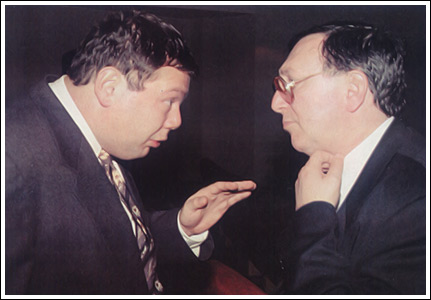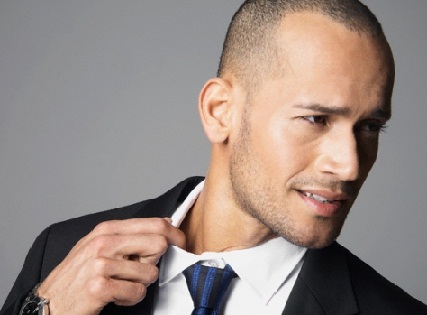
Magnitiza
How to recognize deception in body language and facial expressions
A sharp knife won't hurt you like a lie will hurt you like vile gossip.
Brant S.
The human body is perfect and obeys its owner,
however, even the most persistent person is not able to fully control his emotions, which are expressed in gestures and facial expressions. If you know this language, then recognize deception won't be difficult.
But it must be taken into account that no two people are alike
and, since we lie in different ways, everyone has their own facial expressions. Deception can be noticed and recognized when it is emotional. Emotions contribute more active manifestation
facial expressions, but confirmation of deception, which requires tension and self-control, must be sought in the totality of speech, gestures and facial expressions. 
Hidden or obvious tension can be noticed if you look closely to the left side of the body , which is less controlled by the brain than the right one. The left hemisphere powers the mind and is responsible for speech, while the right hemisphere is responsible for imagination and emotions. Due to the fact that both hemispheres work simultaneously, the right hemisphere is reflected in the work of the left side of the body, and the left hemisphere is reflected in the work of the right.
Insincerity is most often indicated by inconsistency in the actions of body parts. The face is also forced to show dual emotions: those that a person seeks to show, and those that he wants to hide. Therefore, the language of facial expressions and gestures looks asymmetrical. A typical example is when a person smiles from only one corner of his mouth. The most curious thing is that negative emotions more noticeable
precisely on the left side of the face, while positive ones are reflected evenly. 
Facial expressions and lying gestures are closely related. When deceiving, a person may unconsciously hide his hands in his pockets or behind his back, or, conversely, actively gesticulate.
Can confirm or deny deception interlocutor's posture. The more unnatural it is, the more uncomfortable the current situation is for him. This is also indicated by frequent changes of posture and attempts to find a more comfortable position.
Movements. A person who tells the truth leans towards the interlocutor, a liar, on the contrary, moves away. During communication, many people unconsciously use mirroring - they repeat the gestures of their counterparts. When a person lies, this subconscious reaction is suppressed. Restless hand position (smoothing hair, adjusting a tie, wanting to squeeze something) also reveals a liar.
Speech accompanies facial expressions and gestures. Evasive answers to questions posed, tongue-tiedness, additional phrases like « honestly”, “you can trust me”, “I’m absolutely frank with you”
, - all this only emphasizes insincerity. 
9 lying gestures
Before you begin to consider gestures with which you can identify a liar, it is necessary to clarify that the information is valid in two directions, that is, if a person listens to another person lying and at the same time covers his mouth, this can serve as clear evidence of his distrust of the interlocutor’s words.
 1 gesture - Covering your mouth with your hand
1 gesture - Covering your mouth with your hand
The most dangerous picture for a person speaking in front of an audience is that all his listeners have their hands to their mouths. You can get out of the situation by asking the listeners about their objections, but this method is suitable if you are confident in the reliability of the information or can answer questions in such a way as to regain confidence in yourself.
An attempt to cover your mouth with your hand in a conversation with one to three people will be less expressive than in the previous case. The hand at the mouth of your interlocutors will last no more than a couple of seconds. It is possible to say with certainty that this is a lie only based on the context; in addition to a lie, this gesture may indicate doubt, uncertainty or exaggeration of real facts.
 Gesture 2 - Protect your mouth with your hand.
Gesture 2 - Protect your mouth with your hand.
This gesture differs from the previous one in its greater expressiveness. The hand covers the mouth while the thumb is pressed to the cheek. In this case, the duration of the gesture can be quite long or even from the beginning to the end of the conversation. Variations in gestures can indicate how much the listener does not trust his interlocutor. Depending on the position of the hand - for example, a fist completely covering the mouth, the gesture may indicate that the liar has completely failed, or that his speech is not at all what the interlocutor was expecting. Inappropriate coughing while covering your mouth with your fist may indicate an attempt to hide the gesture in question.
 Gesture 3 - touching the nose.
Gesture 3 - touching the nose.
A gesture that everyone has heard about and often interprets as a clear sign of deception. But it's not that simple. First, it is worth saying that as such, touching the nose while deceiving (or listening to an obvious lie) will be subtle (unlike simply scratching the nose). Secondly, touching the nose itself, while lying, is a disguise of the previous two  gestures Thirdly, it will be much more difficult to expose a woman in a lie, since women make this movement much more carefully, so as not to smear their lipstick. And fourthly, in addition to lying, this gesture can be made when negative thoughts appear. That is, the person is not necessarily deceiving; maybe the news he is talking about is not desirable for him and he does not want to report it. Therefore, we remind you again - do not forget about the context.
gestures Thirdly, it will be much more difficult to expose a woman in a lie, since women make this movement much more carefully, so as not to smear their lipstick. And fourthly, in addition to lying, this gesture can be made when negative thoughts appear. That is, the person is not necessarily deceiving; maybe the news he is talking about is not desirable for him and he does not want to report it. Therefore, we remind you again - do not forget about the context.
 Gesture 4 - Rubbing the eyelid.
Gesture 4 - Rubbing the eyelid.
The desire to hide and distance oneself from deception leads to the appearance of this gesture. By the way, just like the desire not to look into the eyes of a person who is being told a lie. The gesture is quite obvious, but sometimes it can be difficult to notice. Again, the difference in the performance of this gesture by a man and a woman is evident. Women are again saved by makeup; to preserve it, the gesture is transformed into a careful providence of a finger under the eye, although at the same time they will have to sharply turn their gaze upward. It is easier to catch a man; if the lie is very serious, then the excitement will force him to vigorously rub his eyelid, while his gaze will be directed either to the side or to the floor. 
Gesture 5 - Clenched teeth
Probably not quite a gesture, but rather a technique to “play to the public.” Speaking through clenched teeth is the main technique of actors to help show the insincerity of their characters. For example, when cops in films arrest criminals, they don’t very politely read them their rights.
 Gesture 6 - Scratching and rubbing the ear.
Gesture 6 - Scratching and rubbing the ear.
At the beginning of the article, we gave an example of children who do not listen to their parents’ lectures. As a person grows up, he hides this gesture much better without causing discontent among others. Almost any prolonged touch to the ear can indicate a lie, or a lack of desire to listen to the interlocutor; in addition, a person can give such a signal when he simply wants to voice his opinion.
Gesture 7 - Scratching the neck. 
Scratching the side of the neck or the area under the earlobe with the index finger of the right hand (much more often the right rather than the left) is a fairly obvious gesture. This is essentially a continuation of the previous gesture if a person has poor knowledge of body language and does not have time to track such an obvious gesture that betrays him. Nevertheless, having seen such a movement, you can almost certainly say that the interlocutor does not agree with your words or with his own. Interesting fact - usually the number of scratches is 5.
 Gesture 8 - Pulling the collar.
Gesture 8 - Pulling the collar.
Most of the gestures in the article are due to the fact that lying causes an itching sensation in the facial muscles, as well as in the muscle tissues of the neck, requiring scratching to relieve the unpleasant sensation. During deception, when the liar is wearing a shirt, scratching his neck openly will not work, but you can fidget with the collar or simply simply pull it back. In addition, cold air allows you to get rid of beads of sweat (they also indicate possible anxiety due to deception). The gesture can also be seen when a person is upset or angry. To completely confuse the situation when you see this gesture from a person after some statement, you can ask him to repeat it.
Gesture 9 - Fingers in mouth. 
That carefree time when the child suckled at the breast of matter and was not bothered by any problems is irrevocably gone. Imperceptibly biting your finger or fist, putting a cigarette or pen in your mouth is all an attempt to return to that distant state of security. This gesture is not particularly suitable for detecting deception, but it speaks of obvious uncertainty.
What to do if it seems that your interlocutor is deceiving:
- Listen to his speech and look at his gestures, starting to behave the same way . In this situation, it will be much more difficult for the deceiver to lie.
- Don’t try to expose him and accuse him of lying. Pretend that you did not hear the last phrase and give your interlocutor a chance to tell the truth.
— Formulate direct questions
, in response to which it is difficult to lie. 
Research by psychologists has revealed several interesting facts about the theory of lies:
- The more sociable person , the more often he resorts to deception. Most often people cheat during telephone and personal communication, in writing lies are less common. Apparently, it hurts the eyes of the writer himself.
— Each person has his own reasons for lying: most often men do it in order to present themselves in a more favorable light, and women do it to create more comfortable communication for the interlocutor. At the same time, the frequency of lies both sexes are the same.
— Men's behavior when lying is different from women's. There is an opinion that lies to women
is given more comfortably. But, no matter how sad it may sound, deception is part of everyday life and it is simply impossible to avoid it
, because for the first time a person comes to this already in the third or fourth year of life. 
If you liked it, please share with your friends and acquaintances by clicking on the buttons. I will be grateful to you!